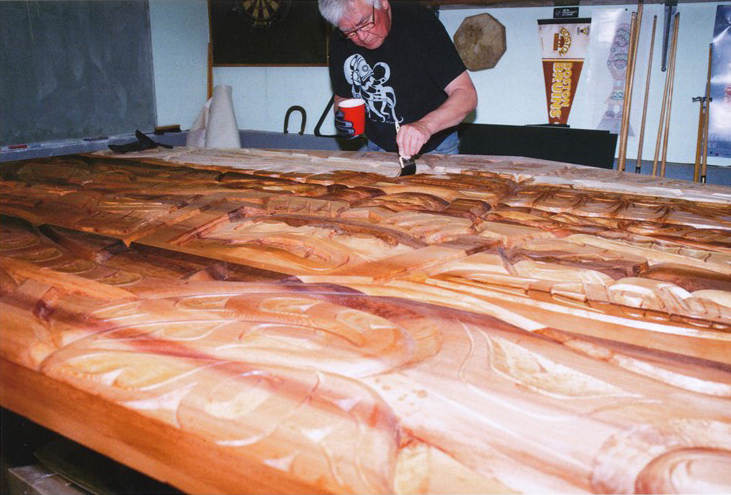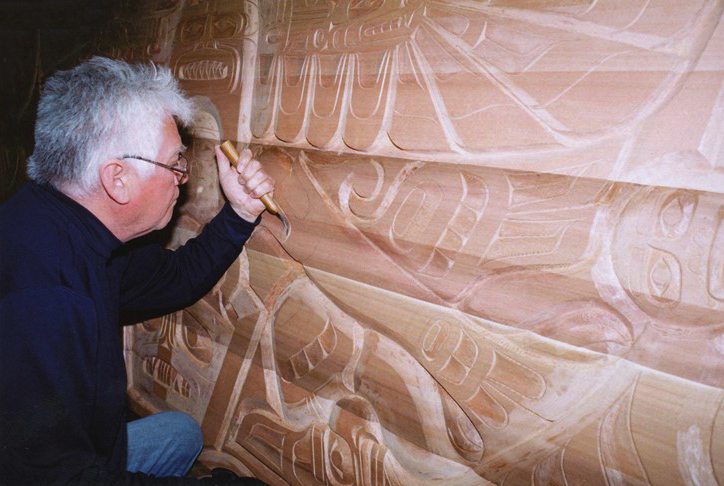About Richard
Richard Hunt was born in Alert Bay, British Columbia in 1951 but has lived most of his life in Victoria. He began carving with his father, the late Henry Hunt, at the age of thirteen. In 1973, Richard began work at the Royal British Columbia Museum as an apprentice carver under his father and the following year assumed the duties of chief carver in the Thunderbird Park Carving Program.
In 1986, Richard Hunt resigned from the Royal British Columbia Museum to begin a new career as a freelance artist. He comes from a family of internationally respected artists, which include his father Henry Hunt and family friend Mungo Martin.
1991
Richard Hunt received the Order of British Columbia "in recognition of serving with the greatest distinction and excellence in a field of endeavour benefiting the people of the Province of British Columbia and elsewhere." This prestigious award program was established in 1990. Richard is the first native artist to be so recognized. In 1994, Richard received the most prestigious award of his career, The Order of Canada.
“The Order was established in 1967 as a means of recognizing outstanding achievement, honouring those who have given services to Canada, to their fellow citizens or to humanity at large.”
—
2004
Richard was accepted into the membership of the Royal Academy of the Arts in recognition for his outstanding achievements within the visual arts. That same year, Richard received an Honorary Doctorate of Fine Arts from the University of Victoria. This prestigious award has a special meaning for Richard because his late father, Henry Hunt was awarded the same degree in 1983.
—
2009
Richard received the BC Creative Achievement Award for Aboriginal Art. Premier Gordon Campbell stated:
"By interpreting what they see, what they experience and their great cultural traditions, these artists provide a gift to all British Columbians through their artwork”
—
—
2016
In April, the Victoria TC 10K road race chose Richard Hunt's design, "Kulus" as their race logo. And in May, Richard unveils his latest work, "My Family" on permanent display in the new Harbour Air Seaplanes Terminal.
—
2018
November, BC Ferries unveils Richard's artwork, "Komokwa", which will be featured throughout its newest vessel, The Sea Wolf.
2020
Richard created a beautiful 6 foot carving titled, “My Family 2”, for private collector’s in Ontario.
2021
Richard repainted the totem pole he carved at the Royal BC Museum in 1979. The totem is now fully restored and standing proudly near Mungo Martin’s house on the corner of Douglas and Belleville.
Richard continues his love of carving while working on pieces he enjoys doing, like the eagle frontlet, the raven frontlet and the frog bowl, pictured in the NEWS and FEATURED section. Stay tuned..
2022
Richard continues working on pieces for private collectors. He is currently working on a sun mask and a set of wings for a totem pole he carved 32 years ago.
2023
Richard is currently working on a large carved plaque for a new office building in Victoria, B.C.
Richard Hunt's Indian name is highly appropriate, considering his accomplishments. Gwe-la-yo-gwe-la-gya-lis means "a man that travels and wherever he goes, he potlatches." Through his art, Richard Hunt has indeed given much to the world.
Artist Statement
I try to remember to thank our ancestors for keeping our traditions and culture alive. They went through a lot of hardship for us. The main influence in my artwork came from my father, Henry Hunt, as well as from Willie Seaweed's work. These are the people who turned our works from being considered a craft to being regarded as historical art. I believe the time has come to recognize our works as cultural property. When I make something, I am claiming the rights to it for myself, and at the same time for our children and all Kwakwaka'wakw people. They are the ones who really own it.
I was thirteen when I decided that I wanted to be a carver. My brothers and I had gone berry picking in Saanich to make money. I dreamt of berries all that night, and woke up the next morning knowing that I wanted to be a carver like my dad. My mother told me to go and learn from my father, and that's how I started, making little paddles and masks. It was a hobby that turned into a way of making an income through my school years. The more I carved, the more I realized that what I was carving came from my culture. That is why I believe that what I create is cultural property and it is my job to educate the public about my culture as much as I can to keep it alive.


